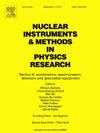CMS RPC efficiency studies using Tag-and-Probe method in LHC Run 3
IF 1.5
3区 物理与天体物理
Q3 INSTRUMENTS & INSTRUMENTATION
Nuclear Instruments & Methods in Physics Research Section A-accelerators Spectrometers Detectors and Associated Equipment
Pub Date : 2025-04-16
DOI:10.1016/j.nima.2025.170492
引用次数: 0
Abstract
CMS experiment is collecting data on proton–proton collisions at the centre-of-mass energy of 13.6 TeV in LHC Run 3. The RPC detector is one of the sub-detectors of the CMS muon system which is capable of triggering and reconstructing muons. In this paper, efficiency of the CMS RPC detector during the Run 3 data taking period is presented. The Tag-and-Probe method with the decay of the Z boson to two muons was used in measuring the efficiency of the operating RPC detector. The efficiency is derived from the matching of RPC hits with probe muons extrapolated to the RPC.
在大型强子对撞机运行 3 中使用标签和探针方法进行 CMS RPC 效率研究
大型强子对撞机运行3的质心能量为13.6 TeV, CMS实验收集了质子-质子碰撞的数据。RPC探测器是CMS μ子系统的子探测器之一,具有触发和重构μ子的功能。本文介绍了CMS RPC探测器在Run 3数据采集周期内的效率。利用Z玻色子衰变为两个μ子的标签-探针法测量了运行RPC探测器的效率。效率来源于RPC命中与外推到RPC的探针μ子的匹配。
本文章由计算机程序翻译,如有差异,请以英文原文为准。
求助全文
约1分钟内获得全文
求助全文
来源期刊
CiteScore
3.20
自引率
21.40%
发文量
787
审稿时长
1 months
期刊介绍:
Section A of Nuclear Instruments and Methods in Physics Research publishes papers on design, manufacturing and performance of scientific instruments with an emphasis on large scale facilities. This includes the development of particle accelerators, ion sources, beam transport systems and target arrangements as well as the use of secondary phenomena such as synchrotron radiation and free electron lasers. It also includes all types of instrumentation for the detection and spectrometry of radiations from high energy processes and nuclear decays, as well as instrumentation for experiments at nuclear reactors. Specialized electronics for nuclear and other types of spectrometry as well as computerization of measurements and control systems in this area also find their place in the A section.
Theoretical as well as experimental papers are accepted.

 求助内容:
求助内容: 应助结果提醒方式:
应助结果提醒方式:


